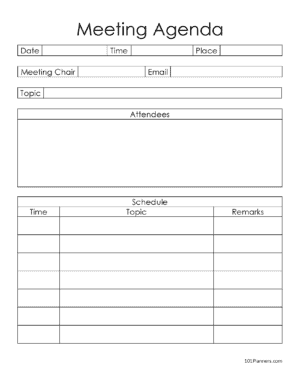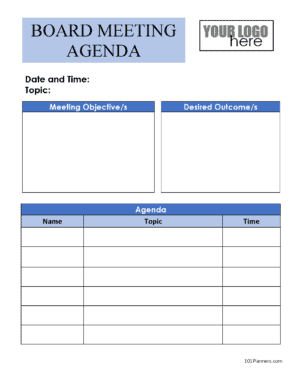

While not every meeting has an agenda, the most effective ones do. It doesn’t have to be wordy, but the meeting should have a purpose with a desired outcome in order to be effective.
In the modern world, it is no secret that many people dread meetings. This is because they dread gatherings that don’t feel structured, drag on for too long, and don’t respect their time. By setting meeting goals and creating a meeting agenda, you are able to run meetings that feel worthy of the time of those in attendance. See also meeting minutes template.
A meeting agenda is a document created before the meeting that lists the agenda items and how much time will be devoted to each item. It is created by the person who is running the meeting.
A meeting agenda is effective when it clearly states the meeting’s goals and discussion topics. This keeps everyone in attendance on the same page and gives the person running the meeting an idea of how to run things.
The agenda should list the agenda items or discussion topics in order. These can be listed as bullet points. In fact, brevity is often better when it comes to an agenda since the important factor here is clarity.
It is hard to keep the meeting on topic if anything is vaguely written.
You can create as detailed or minimal an agenda as you wish. However, here’s a good way to create a basic meeting agenda.
Each of the templates above is available in Word, Excel, as an image, and a PDF. The PDF is editable and you can type your details before you print or save.
You can edit any of the Microsoft Word templates above in Google Docs.
We offer 14 free meeting agenda examples for you to edit as you please. Choose the printable meeting agenda format that is closest to the one that you want to use and edit it if you want to make any changes.
Our free agenda templates are available in different formats. If you find a meeting agenda template that you like as-is, you can download the editable PDF or the image file. You can type on the editable PDF file and then save or print it.
If not, select the meeting agenda template Word version if you want to make any changes to the layout or wording. We also offer an Excel format for those who prefer to use a spreadsheet for minute-taking.
A generic meeting template that includes the meeting objectives or goals of the meeting, meeting notes, attendees list, and the time allocated to each agenda item. This generic meeting template can be used for PTA meetings, community meetings, workplace meetings, conferences, neighborhood meetings, team share-outs, and club meetings.










These meeting templates are for more formal meetings such as board meetings. If the same board members participate in the meetings each time then you might want to add their names to the Microsoft template instead of typing them each time. For a big formal board meeting, you can put a copy of the agenda in the boardroom for each participant so that they can review it before the meeting. You might want to give each participant a notebook and a pen if they usually take notes.


If you have the same meeting participants each meeting then add their names to the Microsoft Word template instead of adding the list for each meeting.


Set meeting goals before each meeting with clear expectations for the outcome of the meeting. If you don’t have goals for the meeting then don’t have a meeting. It will simply be a waste of time. For example, if you are having a project kickoff meeting then the goal will be for all participants to leave the meeting with a clear understanding of the project, its objectives, and each person’s responsibilities and tasks from the beginning until the end of the project (the deliverables).
Writing an agenda for a meeting is the first step. The agenda makes the meeting more effective by providing structure and focusing on the relevant issues. If you give everyone in attendance a copy of the agenda beforehand, then everyone has time to prepare and be on the same page before the meeting begins.
Bonus Tip: Sending out the agenda and asking the attendees if they have anything they want to add to the agenda before the meeting is a great way to keep things on task in the event. It keeps attendees from bringing up other topics in the middle and helps you plan in case someone has a worthy topic.
While the agenda adds structure to the meeting, the meeting minutes give you something to take away from it.
If your agenda has notes on time for each discussion topic, stick to that timeline. If the topic isn’t wrapping up and the time is up, then you are allowed to say that this will need to be handled at another time because this meeting doesn’t have room for all of this.
Give your meeting some time for wrapping up each of these discussion topics. After each discussion topic has happened, you want to take a minute or two as the leader to state the clear takeaways from that discussion. This will help the Secretary so they clue in on what needs to be written in the minutes. It will also help everyone in attendance to be sure they’re on the same page.
The most effective meetings conclude takeaway actions. Before you hold your meeting, give some thought to the action items you would like to discuss and who will be responsible for each one. Be specific on action items. If you expect a specific person to do a specific thing after this meeting, state that very clearly.
Before the meeting, check the agenda from the previous meeting to ensure that there are no open items that were not completed.
Make sure that when you assemble your agenda, you put your most vital discussion topics first. Sometimes people are tempted to save the best for last or lead into those topics, but if you run out of time, it is important that your most important topics get hit on first. Use your time wisely.
Take meeting minutes during the meeting or after it. This way, everyone has their takeaways.
There are many reference guides available that describe rules of procedures as to how meetings should be conducted.
Robert’s Rule of Order or various versions of it are used by approximately 80% of organizations in the United States (Source).
The second most commonly used parliamentary authority is Sturgis Standard Code of Parliamentary Procedure, used by approximately 15% of groups (particularly physicians and dentists).
The third most popular parliamentary manual is Demeter’s Manual of parliamentary Law and Procedure, used by about 5% of groups (particularly unions).